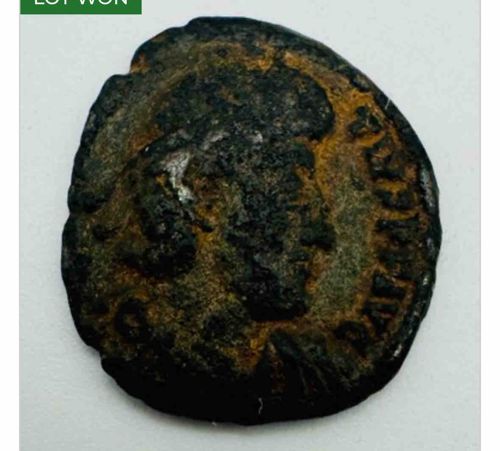
Ancient Roman Coin (Bronze Follis)
This item is an ancient Roman coin, likely a bronze follis, characterized by its dark, heavily patinated surface. The coin exhibits a generally circular, albeit irregular, shape with areas of erosion and chipping along the edges, suggesting significant time in circulation or burial. The primary visible feature on the obverse is a portrait of an emperor or prominent figure, facing right. While the details of the facial features are largely obscured by wear and corrosion, the general outline of a laureate or radiate head is discernible. Around the periphery, fragmented Latin inscriptions are visible, with letters such as 'A', 'T', 'L', and 'IA' tentatively identifiable, indicating it once bore the emperor's name or title. The material appears to be a bronze or copper alloy, common for currency of that era, and it has developed a thick, uneven dark brown to black patina with reddish-brown oxidation spots, typical of archaeological finds. The surface texture is rough and granular due to mineral deposits and corrosion. There are no clear maker's marks or mint symbols immediately visible in the provided image. Given the style of the portrait and the visible inscription fragments, this coin most likely dates to the Late Roman Empire, possibly 3rd or 4th Century AD. The significant wear and environmental damage indicate it is in 'poor' to 'fair' condition based on numismatic grading standards, as much of the original detail has been lost. The craftsmanship, though difficult to assess fully due to condition, appears to be consistent with mass-produced coinage of the period, not exceptional artistic quality.
AI-Generated Appraisal Disclaimer
Estimated Value
$10-30
Basic Information
Category
Ancient Coin
Appraised On
November 30, 2025
Estimated Value
$10-30
Item Description
This item is an ancient Roman coin, likely a bronze follis, characterized by its dark, heavily patinated surface. The coin exhibits a generally circular, albeit irregular, shape with areas of erosion and chipping along the edges, suggesting significant time in circulation or burial. The primary visible feature on the obverse is a portrait of an emperor or prominent figure, facing right. While the details of the facial features are largely obscured by wear and corrosion, the general outline of a laureate or radiate head is discernible. Around the periphery, fragmented Latin inscriptions are visible, with letters such as 'A', 'T', 'L', and 'IA' tentatively identifiable, indicating it once bore the emperor's name or title. The material appears to be a bronze or copper alloy, common for currency of that era, and it has developed a thick, uneven dark brown to black patina with reddish-brown oxidation spots, typical of archaeological finds. The surface texture is rough and granular due to mineral deposits and corrosion. There are no clear maker's marks or mint symbols immediately visible in the provided image. Given the style of the portrait and the visible inscription fragments, this coin most likely dates to the Late Roman Empire, possibly 3rd or 4th Century AD. The significant wear and environmental damage indicate it is in 'poor' to 'fair' condition based on numismatic grading standards, as much of the original detail has been lost. The craftsmanship, though difficult to assess fully due to condition, appears to be consistent with mass-produced coinage of the period, not exceptional artistic quality.
Related Tags
Get Your Items Appraised
Instant estimates of your treasures with AI-powered instant appraisals